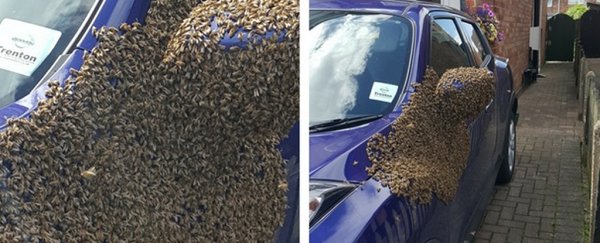The last thing you want to find coming home on a Sunday afternoon is a swarm of some 20,000 bees covering your car. But that's exactly what happened to Shirley Taylor from Hull, UK just this weekend.
The whole block went into involuntary lockdown as the swarm of bees literally took over the bonnet of Taylor's car, and stung several people in the process. But bees are really precious insects, so all they could do was steer clear and call the local beekeepers to the rescue.
Swarming is a seasonal process that honeybees go through when their existing colony becomes too large, and a new queen bee leaves it with a huge group of worker bees in tow. The swarm picks an interim spot to hang out for a few hours and sends out scout bees to look for a suitable new home, typically a tree cavity.
It's a dangerous process for bee swarms to be travelling out in the open in search of a new nest. They can't pack a lunch and have to subsist on whatever honey and nectar they've gobbled down in preparation for the trip - if they don't find a new home in time, the whole swarm can even starve.
To rescue the swarm, Mrs Taylor and her car, the chairman of the local Beverley Beekeeper's Association Chris Coulson was called into action.
At first it wasn't clear why the bees chose the blue Nissan car and he and a colleague were trying to determine whether this was just a temporary stop or a new nesting site.
But as the bees moved to the inside of the bonnet, filling every nook and cranny, things got more serious.
"They're building a lot of wax in there now, and of course once they start doing that, they're reluctant to leave it, because it's the start of building a house. They put a lot of effort into producing the wax," Coulson told Hull Daily Mail.
"I've got a feeling this might be their chosen permanent home."
To capture a swarm and take it away, beekeepers can use bee larvae and eggs inside a large box - as the honeybees sense these larvae, they move in to cover and protect them, and the whole swarm ends up safely nested inside to be moved to a more appropriate location.
"We will be working for as long as we can to get the bees out, but it's going to be a long process," said Coulson.
We're still waiting to hear on whether every last bee has been moved from Mrs Taylor's car, who says she only bought it last September and was hoping to avoid any damage to it.
Weirdly enough, it's not even the first time bees in the UK have demonstrated a weird car obsession. Just last year, thousands of bees chased a poor woman in a Mitsubishi Outlander for two whole days.
Beekeepers trapped the swarm and took it back to the local national park where the bees had first showed up and started following the car. But that wasn't the end of it. The very next day, the swarm was back, buzzing all over the car again to the surprise and amusement of the beekeepers.
They hypothesised that the queen bee could have been trapped in the boot of the car or at least left its pheromones on it, making the vehicle an irresistible attraction that had to be followed at all costs.
While these misplaced bee swarms are unusual cases, swarming itself happens regularly, so you may end up facing a buzzing ball of bees yourself. If that ever happens, remember that these important pollinators should not be harmed.
Instead, look for information from your local council on whom to contact in case of a bee emergency. After all, they're just looking for a new home, and it's not their fault that they look really terrifying while doing it.
